Note: After you click on images to ENLARGE them, you may find they automatically size smaller in your browser's window making them hard to read. The auto sizing is your browser's way of keeping images entirely within the screen size you have set. If this happens, you will see a small box in the bottom right hand corner of the pic with four arrows point outwards. Click this box and the pic will EXPAND and open up to its normal size, so you should now be able to read any text and make out small details.
Originally Posted by :
Unlike the same meat, different gravy L39, the now famous L42 was programmed differently. But before we go on a bit, let’s drop a whole bucketful of praise onto this famous Enfield offering. True, it is probably the rarest of the breed, possibly the most expensive, its price is rocketing skywards as we speak, in fact terms like world economic depression are almost alien to its upwards spiraling prices. It is without doubt, as accurate as anything before it and even though I’ll say it quietly, in reverence to the L96 stable, since….., but………… ! You’ll realize now, that all was not good about the L42 and I’ll tell you why…………….
The conversion programme from No4T to L42 was, as we all know, undertaken in several tranches at Enfield between 1970 and 81. The butts, if they were serviceable, remained with the original rifle and the same applied to the fore-ends but unlike the butts, the fore-ends were to be modified by an outside contractor. The reason for this is unknown to the author in spite of asking many questions. But it’s felt that there was little wood-machining facilities remaining at the Enfuield factory at the time. Additionally, even if there were, the facilities that did remain, a left-over from the L1A1 era, the General Staff Requirement (the GSR) of 1080 L42s was insufficient to re-start it. But there you go! In their previous morphication from No4 to No4T, then if it was accurate enough to be selected as a telescope rifle as a plain No4, then provided it was put back, as it was, after conversion, then the accuracy would remain. And as a general rule, it did. This was (presumably) the thinking back in the 70’s. Put the same fore-end back onto the rifle and it should retain its accuracy as before.
Of course there were several differences. The first being that the fore-end was shorter BUT, as there was no barrel bearing from the reinforce forward, then already, life is easier. Additionally, if the OLD No4 barrel and body was a proper fit in the fore-end at the reinforce then given that the new reinforce was machined to exactly the same dimensions, then that too would be a perfect fit. And by and large, they were. So far, all is well ….., in theory.
The problems start when the fore-ends are sent out on a rotating basis to an outside contractor for conversion. Cutting the front end off is simple but it’s the simple mathematics of routeing a 1” half-round groove down a fore-end that’s narrowing towards the front that are flawed. When the 1” half round cutter gets to the front of the ‘new’ shortened fore-end, you’re left with a wood thickness of anywhere between .050 and .070” thickness of wood at the top edges. What planet were they really on? Did they really need a 1” wide channel when the new barrel was only .830 or so in diameter? I ask this because when Armourers were fitting new fore-ends at Field and Base workshops, they would slide a .020” shimmed spacer between the barrel and fore-end, right down to the reinforce and if it cleared all the way, that was sufficient. So, .870” (.040” + .830”= .870”) is all that was really needed for the new barrel channel. That way you’d have a bit of meat spare on each of the top front ends of the fore-end. But no………. It wouldn’t be half as bad if the bodger with the routeing cutter machine routed it down the centre of the fore-end. But no! Of all those fore-ends that I’ve seen, it’s slightly off centre to the extent that while even the thicker side is thin, the thin side is, well……………
But that’s not all. After the conversion process, the fore-ends have been scraped or sanded off to within an inch of their lives. But not as you’d expect a half decent Armourer to do it ….. Oh no, not with a bit of care and thought as he’d been taught over years and years of his apprenticeship and during his service of care and consideration. The contractor had gone hammer and tongs with what seems to be a sanding belt and in doing so, had rounded the top edges making them thinner than the thin-ness they are already but also has run the sander into the upper band recess and as you’ll see later, has caused even more problems. Let me give you an example. At one particular Infantry unit I was charged with overseeing, the snipers would pull the sling tight, almost wrapping it around their am and body and in doing so, pulling the top band backwards at they did so. You’ve got it in one! The fore-end at the band part was so sanded away that there was insufficient support for the band by what should be the edges of the band recess in the wood. So, the band would just pull in and chip away and take a gouge or two out of the bottom of the fore-end. Then the top of the band would draw down into the band groove in the handguard and that’d split too. And so far, we’re only with the original Mk1 fore-ends already fitted! It gets even worse when it comes to the spares stockpiles ordered next!
As fitting a fore-end was a Field Workshop repair, the rifle, with its split handguard and fore-end would make its way to the workshops. There, in the days of plenty, a new fore-end would be ordered from Ordnance. The old handguard and fore-end would be put into a rack waiting for the day that once a pile had been gathered, they’d all be repaired in one hit. The ‘new’ fore-end would duly arrive from Ordnance. But that was only half the battle because the ‘new’ fore-end had been converted by the same butchers who had converted the original. Even previously new Mk2 types that were retro-modified to Mk1 spec were sanded to within an inch of their lives too, with thin front ends and off centre barrel routing channels. As for the modification to the rear, to retro modify from ‘open rear’ Mk2 to ‘closed rear’ Mk1 spec, well, words fail me! Many of those that I’d encountered were simply a bodge too. For example, even the back strap (that replaced the Mk2 type tie bolt and nut) wouldn’t sit into the recess machined for it, making it impossible to fit to the rifle right from the start.
Armourers soon started to file defect reports about the situation. I saw one with the report came back from Ordnance to the effect that ‘……..most of the retro modified fore-ends were converted from second hand stocks, taken from scrapped or other well worn rifles and their condition reflect this’ But that in itself was incorrect. Clearly some of the converted fore-ends were clearly converted from NEW stocks of Mk2 fore-ends. Indeed, some I saw were retro converted from a brand new very late Mk2 Fazakerley fore-end configured for the UF55A type rifles …., you know the sort, the partially completed No5 rifle bodies without the original cut-off block. We know this because Sgt Roger Xxxxx had to cut this away from the fore-end before he could even start to fit it to the rifle! I actually saw a new fore-end come straight from Ordnance, with the front top edges so thin that when the Armourer saw it, he came over to me, commented on it, pressed it between his finger and thumb and it cracked away before my very eyes. Yes, they were an absolute disgrace. As if to make them look a bit better (difficult…..) it looked as though they’d been given a bit of a quick blow job with a can of cheap varnish. Words fail me
It soon became apparent that it was easier to forget about ordering ‘new’ fore-ends and simply repair what you had. At least you knew it fitted! This was achieved by undercutting and dovetailing in a 2” or so long patch x 1” or so deep at the front of the fore-end and extending it an inch or so behind the upper band so that by carefully making good, you could a), leave the top much wider by narrowing the barrel groove/channel and b), leave a LOT more wood to the front and rear of the band recess. The accompanying photographs show a selection of the repaired fore-ends and some of the methods used by the older Armourers. Apologies about the picture quality as some of these are taken from old photographs taken during the era, to highlight the problems. They do also show just how you can go about completing a similar repair to your own rifle should you need to. But just remember this. ONLY TAKE OUT THE MINIMUM OF WOOD FROM THE NEW BARREL CHANNEL. The minimum is the diameter of the barrel PLUS .020” clearance all around.
As a sop to make the best use of many otherwise ‘serviceable’ fore-ends, a small plate was inserted into and under the front of the trigger guard. It would appear that this plate was done to all replacement stocks but not necessarily to the original fore-ends unless it was required. This WAS a good idea but not a ‘new’ idea because the gun trade had been using a similar ploy for many years
As for the handguards, well, the converted No8 handguards were the first to go because being originally wider than the No4 fore-end, they were also slimmed down on the sander to within an inch of their lives and in turn, this had left the front end about as marginal as the fore-ends! The later ‘new manufacture’ handguards were much better but during the mid 80’s, these were in short supply and with trials being undertaken to replace the trusty old steed, no more were ordered. Maybe Ordnance had got the message about the pxxx-poor quality of the bodgers involved earlier! When this happened, many Armourers were made aware of the shortage of serviceable L42’s and reverted to the converting of No4 rear handguards by extending them forwards to fill the need. You’ll still find these on some L42’s but you’ll have to look hard to see the join, under the band and inside, extending rearwards. An external giveaway is the small wooden plugs in place of the brass liner rivets. The quality of these REME Armourers repairs and conversions is a testimony to their years of apprentice and on-the-job training. A far cry from the diabolical workmanship of the original bodgers that they’d encounter later.
Later, we’ll take one of the bodged and split original fore-ends and show you how to do a proper, old time REME Armourers repair. If you’ll help Roger!
As Sgt Roger Xxxxx said to me once while we were ‘busy’ range testing a few ‘……….the rifle is just SO accurate, it’s a credit to Enfield - and that’s in SPITE of the fore-end, not because of it’. I couldn’t have put it better myself Roger! Oh yes…., a word of advice and warning. If you see him or any other old-time Field and Base workshop Armourer of the 70’s and 80’s, please don’t mention L42 rifle fore-ends and handguards because you’ll soon learn that they all suddenly suffer from rabid outbursts of Tourettes syndrome and a robust reply can sometimes offend
In our next installment, "The L42 and 39 Fore-ends" (click here), we’ll show how a needy fore-end can be saved from the great scrap-bin in the sky. Thanks to Armourer Sgt Roger Xxxxx for the technical explanations and old defect report photos.
These show the front or muzzle end of the converted No4 fore-ends for the L42 rifle. They’re pretty well self explanatory and the thinness of the wood is clear. Is it any wonder that as soon as the sniper tightened his sling on his arm, the wood would just crack …, then crumple! Who ever authorized such a ridiculous state of affairs and the two beech fore-ends are brand new and unused, straight from Ordnance!
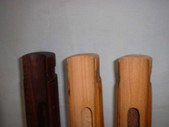 (Click PIC to Enlarge)
(Click PIC to Enlarge)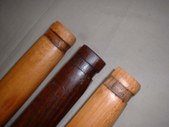 (Click PIC to Enlarge)
(Click PIC to Enlarge)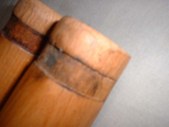
This picture shows the two beech Mk2 fore-ends retro modified back from ‘open rear’ Mk2 spec to ‘closed rear’ Mk1 spec. The workmanship is absolutely appalling. The irony is that there was no reason to retro modify at all because every Armourer knew from years of experience that a Mk2 fore-end fits perfectly on a Mk1 type rifle like the L42!
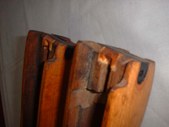
(Click PIC to Enlarge)
Shows two No4 rear handguards extended forwards and made off to L42/39 spec. Quite clearly, these are more substantial that the originals that were soon in short supply once they came on stream! Notice the dowel pegs on the pale birch handguard, used to strengthen/reinforce the rear of the glued patch. As for the original converted No8 type, well words fail me!
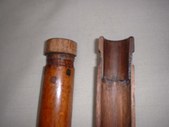 (Click PIC to Enlarge)
(Click PIC to Enlarge)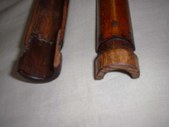
These show two repaired L42 fore-ends, saved from the scrap yard by Armourers at 43 Command Workshops in the late 80’s. Notice that they have both been left substantially thicker at the top front edge while still allowing a minimum of .020” clearance around the barrel. Note the hard oak peg to further secure the patch. I did ask why the lightening recess in the dark fore-end was patched. This was to stop a small longitudinal split. Crikey, there’s almost more patches than wood. Things MUST have been bad!
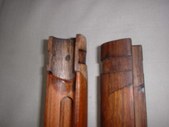 (Click PIC to Enlarge)
(Click PIC to Enlarge)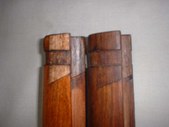
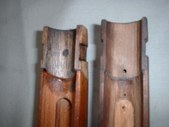 (Click PIC to Enlarge)
(Click PIC to Enlarge)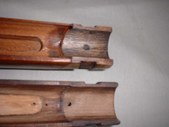
"The fore-end and handguards of the L42"
(Or how to turn a silk purse into a sows ear)
By Peter Laidler
By Peter Laidler
Unlike the same meat, different gravy L39, the now famous L42 was programmed differently. But before we go on a bit, let’s drop a whole bucketful of praise onto this famous Enfield offering. True, it is probably the rarest of the breed, possibly the most expensive, its price is rocketing skywards as we speak, in fact terms like world economic depression are almost alien to its upwards spiraling prices. It is without doubt, as accurate as anything before it and even though I’ll say it quietly, in reverence to the L96 stable, since….., but………… ! You’ll realize now, that all was not good about the L42 and I’ll tell you why…………….
The conversion programme from No4T to L42 was, as we all know, undertaken in several tranches at Enfield between 1970 and 81. The butts, if they were serviceable, remained with the original rifle and the same applied to the fore-ends but unlike the butts, the fore-ends were to be modified by an outside contractor. The reason for this is unknown to the author in spite of asking many questions. But it’s felt that there was little wood-machining facilities remaining at the Enfuield factory at the time. Additionally, even if there were, the facilities that did remain, a left-over from the L1A1 era, the General Staff Requirement (the GSR) of 1080 L42s was insufficient to re-start it. But there you go! In their previous morphication from No4 to No4T, then if it was accurate enough to be selected as a telescope rifle as a plain No4, then provided it was put back, as it was, after conversion, then the accuracy would remain. And as a general rule, it did. This was (presumably) the thinking back in the 70’s. Put the same fore-end back onto the rifle and it should retain its accuracy as before.
Of course there were several differences. The first being that the fore-end was shorter BUT, as there was no barrel bearing from the reinforce forward, then already, life is easier. Additionally, if the OLD No4 barrel and body was a proper fit in the fore-end at the reinforce then given that the new reinforce was machined to exactly the same dimensions, then that too would be a perfect fit. And by and large, they were. So far, all is well ….., in theory.
The problems start when the fore-ends are sent out on a rotating basis to an outside contractor for conversion. Cutting the front end off is simple but it’s the simple mathematics of routeing a 1” half-round groove down a fore-end that’s narrowing towards the front that are flawed. When the 1” half round cutter gets to the front of the ‘new’ shortened fore-end, you’re left with a wood thickness of anywhere between .050 and .070” thickness of wood at the top edges. What planet were they really on? Did they really need a 1” wide channel when the new barrel was only .830 or so in diameter? I ask this because when Armourers were fitting new fore-ends at Field and Base workshops, they would slide a .020” shimmed spacer between the barrel and fore-end, right down to the reinforce and if it cleared all the way, that was sufficient. So, .870” (.040” + .830”= .870”) is all that was really needed for the new barrel channel. That way you’d have a bit of meat spare on each of the top front ends of the fore-end. But no………. It wouldn’t be half as bad if the bodger with the routeing cutter machine routed it down the centre of the fore-end. But no! Of all those fore-ends that I’ve seen, it’s slightly off centre to the extent that while even the thicker side is thin, the thin side is, well……………
But that’s not all. After the conversion process, the fore-ends have been scraped or sanded off to within an inch of their lives. But not as you’d expect a half decent Armourer to do it ….. Oh no, not with a bit of care and thought as he’d been taught over years and years of his apprenticeship and during his service of care and consideration. The contractor had gone hammer and tongs with what seems to be a sanding belt and in doing so, had rounded the top edges making them thinner than the thin-ness they are already but also has run the sander into the upper band recess and as you’ll see later, has caused even more problems. Let me give you an example. At one particular Infantry unit I was charged with overseeing, the snipers would pull the sling tight, almost wrapping it around their am and body and in doing so, pulling the top band backwards at they did so. You’ve got it in one! The fore-end at the band part was so sanded away that there was insufficient support for the band by what should be the edges of the band recess in the wood. So, the band would just pull in and chip away and take a gouge or two out of the bottom of the fore-end. Then the top of the band would draw down into the band groove in the handguard and that’d split too. And so far, we’re only with the original Mk1 fore-ends already fitted! It gets even worse when it comes to the spares stockpiles ordered next!
As fitting a fore-end was a Field Workshop repair, the rifle, with its split handguard and fore-end would make its way to the workshops. There, in the days of plenty, a new fore-end would be ordered from Ordnance. The old handguard and fore-end would be put into a rack waiting for the day that once a pile had been gathered, they’d all be repaired in one hit. The ‘new’ fore-end would duly arrive from Ordnance. But that was only half the battle because the ‘new’ fore-end had been converted by the same butchers who had converted the original. Even previously new Mk2 types that were retro-modified to Mk1 spec were sanded to within an inch of their lives too, with thin front ends and off centre barrel routing channels. As for the modification to the rear, to retro modify from ‘open rear’ Mk2 to ‘closed rear’ Mk1 spec, well, words fail me! Many of those that I’d encountered were simply a bodge too. For example, even the back strap (that replaced the Mk2 type tie bolt and nut) wouldn’t sit into the recess machined for it, making it impossible to fit to the rifle right from the start.
Armourers soon started to file defect reports about the situation. I saw one with the report came back from Ordnance to the effect that ‘……..most of the retro modified fore-ends were converted from second hand stocks, taken from scrapped or other well worn rifles and their condition reflect this’ But that in itself was incorrect. Clearly some of the converted fore-ends were clearly converted from NEW stocks of Mk2 fore-ends. Indeed, some I saw were retro converted from a brand new very late Mk2 Fazakerley fore-end configured for the UF55A type rifles …., you know the sort, the partially completed No5 rifle bodies without the original cut-off block. We know this because Sgt Roger Xxxxx had to cut this away from the fore-end before he could even start to fit it to the rifle! I actually saw a new fore-end come straight from Ordnance, with the front top edges so thin that when the Armourer saw it, he came over to me, commented on it, pressed it between his finger and thumb and it cracked away before my very eyes. Yes, they were an absolute disgrace. As if to make them look a bit better (difficult…..) it looked as though they’d been given a bit of a quick blow job with a can of cheap varnish. Words fail me
It soon became apparent that it was easier to forget about ordering ‘new’ fore-ends and simply repair what you had. At least you knew it fitted! This was achieved by undercutting and dovetailing in a 2” or so long patch x 1” or so deep at the front of the fore-end and extending it an inch or so behind the upper band so that by carefully making good, you could a), leave the top much wider by narrowing the barrel groove/channel and b), leave a LOT more wood to the front and rear of the band recess. The accompanying photographs show a selection of the repaired fore-ends and some of the methods used by the older Armourers. Apologies about the picture quality as some of these are taken from old photographs taken during the era, to highlight the problems. They do also show just how you can go about completing a similar repair to your own rifle should you need to. But just remember this. ONLY TAKE OUT THE MINIMUM OF WOOD FROM THE NEW BARREL CHANNEL. The minimum is the diameter of the barrel PLUS .020” clearance all around.
As a sop to make the best use of many otherwise ‘serviceable’ fore-ends, a small plate was inserted into and under the front of the trigger guard. It would appear that this plate was done to all replacement stocks but not necessarily to the original fore-ends unless it was required. This WAS a good idea but not a ‘new’ idea because the gun trade had been using a similar ploy for many years
As for the handguards, well, the converted No8 handguards were the first to go because being originally wider than the No4 fore-end, they were also slimmed down on the sander to within an inch of their lives and in turn, this had left the front end about as marginal as the fore-ends! The later ‘new manufacture’ handguards were much better but during the mid 80’s, these were in short supply and with trials being undertaken to replace the trusty old steed, no more were ordered. Maybe Ordnance had got the message about the pxxx-poor quality of the bodgers involved earlier! When this happened, many Armourers were made aware of the shortage of serviceable L42’s and reverted to the converting of No4 rear handguards by extending them forwards to fill the need. You’ll still find these on some L42’s but you’ll have to look hard to see the join, under the band and inside, extending rearwards. An external giveaway is the small wooden plugs in place of the brass liner rivets. The quality of these REME Armourers repairs and conversions is a testimony to their years of apprentice and on-the-job training. A far cry from the diabolical workmanship of the original bodgers that they’d encounter later.
Later, we’ll take one of the bodged and split original fore-ends and show you how to do a proper, old time REME Armourers repair. If you’ll help Roger!
As Sgt Roger Xxxxx said to me once while we were ‘busy’ range testing a few ‘……….the rifle is just SO accurate, it’s a credit to Enfield - and that’s in SPITE of the fore-end, not because of it’. I couldn’t have put it better myself Roger! Oh yes…., a word of advice and warning. If you see him or any other old-time Field and Base workshop Armourer of the 70’s and 80’s, please don’t mention L42 rifle fore-ends and handguards because you’ll soon learn that they all suddenly suffer from rabid outbursts of Tourettes syndrome and a robust reply can sometimes offend
In our next installment, "The L42 and 39 Fore-ends" (click here), we’ll show how a needy fore-end can be saved from the great scrap-bin in the sky. Thanks to Armourer Sgt Roger Xxxxx for the technical explanations and old defect report photos.
These show the front or muzzle end of the converted No4 fore-ends for the L42 rifle. They’re pretty well self explanatory and the thinness of the wood is clear. Is it any wonder that as soon as the sniper tightened his sling on his arm, the wood would just crack …, then crumple! Who ever authorized such a ridiculous state of affairs and the two beech fore-ends are brand new and unused, straight from Ordnance!
This picture shows the two beech Mk2 fore-ends retro modified back from ‘open rear’ Mk2 spec to ‘closed rear’ Mk1 spec. The workmanship is absolutely appalling. The irony is that there was no reason to retro modify at all because every Armourer knew from years of experience that a Mk2 fore-end fits perfectly on a Mk1 type rifle like the L42!
(Click PIC to Enlarge)
Shows two No4 rear handguards extended forwards and made off to L42/39 spec. Quite clearly, these are more substantial that the originals that were soon in short supply once they came on stream! Notice the dowel pegs on the pale birch handguard, used to strengthen/reinforce the rear of the glued patch. As for the original converted No8 type, well words fail me!
These show two repaired L42 fore-ends, saved from the scrap yard by Armourers at 43 Command Workshops in the late 80’s. Notice that they have both been left substantially thicker at the top front edge while still allowing a minimum of .020” clearance around the barrel. Note the hard oak peg to further secure the patch. I did ask why the lightening recess in the dark fore-end was patched. This was to stop a small longitudinal split. Crikey, there’s almost more patches than wood. Things MUST have been bad!
Copyright ©2006 - 2009 by Peter Laidler and MILSURPS.COM
Collector's Comments and Feedback:
1. Besides this terrific article by Advisory Panel Member Peter Laidler, there are a few other Knowledge Library entries relating to wood failures and repairs on these old milsurp rifles. A few examples are:
Repairing a Split Stock on a Lithgow SMLE by turkmcl and O_P (click here)
Lithgow SMLE ... Causes of Cracked Foreends by Son (click here)
Repairing a K98k "duffle cut" by Hambone (click here)
There's also an excellent photo pictorial, designed to help the average collector identify the different wood types and finishes on K98k's.
German K98 Stocks and Wood Types by rcmauser (click here)
....... (Feedback by "Badger")
2. In addition to being a trained and highly experienced military "Armourer", Peter Laidler has authored two excellent books about the No.4(T) sniper rifles and their No.32 scopes. They are titled "An Armourer's Perspective: .303 No.4(T) Sniper Rifle", which he co-authored with Ian Skennerton and his own dedicated work, "Telescope Sighting No.32".
If you're really interested in some in-depth learning about the No.4(T) sniper rifles and the No.32 series of scopes, their history, evolution, repair and adjustments for shooting, I'd highly recommend those two books, which are pictured below. ....... (Feedback by "Badger")
Note: The opinions expressed herein or statements made in this article are solely those of the author, and do not necessarily reflect the views of the Military Surplus Collectors Forums, or the ownership and moderation group of this site. MILSURPS.COM accepts no legal liability or responsibility for any claims made or opinions expressed herein. Also, please note that neither the author nor MILSURPS.COM recommends that any member of these forums, or a reader of this article, try this type of experimentation without the proper knowledge, equipment and training.









 Countries
Countries Categories
Categories